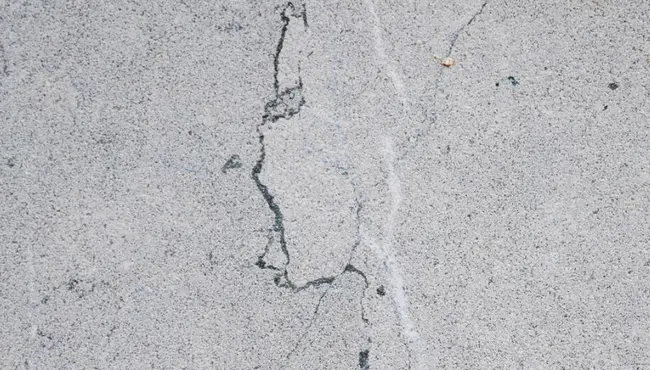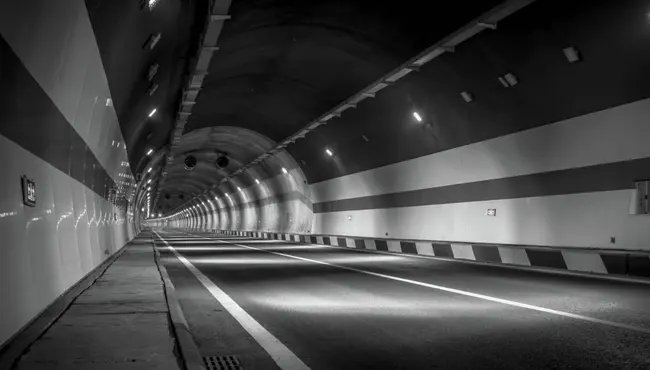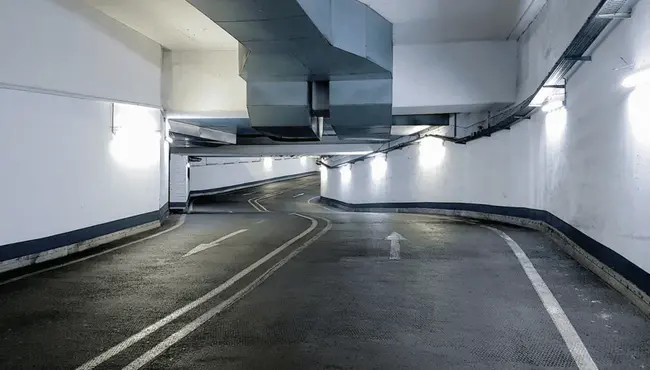
High pedestrian and vehicle traffic areas must withstand heavy wear and tear from trucks, cars, and foot traffic, along with an aggressive environment. Applying proper waterproofing and traffic coating to the concrete design will help stop moisture and chloride inflation that can crack, break, and corrode the concrete structures, leading to costly repairs, disruptive closures, and dangerous safety issues.
Polyguard's 665 Membrane, NW75 Membrane, Cold Flex™ Membrane, and 650 Membrane offer a high-performing, alternative method to traditional traffic coatings. Our waterproofing products protect the pavement against damage caused by pedestrian, vehicular, and specialty traffic, which minimizes maintenance and repair costs and extends the service life of the overlay and pavement.
What is Traffic Coating?

Applying a pedestrian or vehicular traffic coating creates a barrier over a heavy traffic concrete surface that protects it against weather, temperature, and debris. A concrete traffic coating protects against
- Heavy and frequent vehicle or foot traffic loads
- Severe weather conditions (ice, snow, rain, high heat) that can damage concrete
- Extreme temperature fluctuations, particularly in the northern part of the U.S.
- Corrosion of the steel rebar in balconies, parking decks, etc., due to chemicals and salts
- Salt, oils, and other debris tracked in by vehicles
- Debris
Where to Apply Traffic Coatings
Typical applications of concrete traffic coating include:
- Parking garages and decks
- Walkways
- Stadiums
- Footbridges
- Concrete walkways or footbridges
- Rooftop decks
- Outdoor balconies
- Mechanical rooms
How to Apply Concrete Traffic Coating for Waterproofing
The traditional methods for applying traffic coating on concrete depend on the space that requires coating:
- Brush-applied coatings are utilized for traffic coating details in small, hard-to-reach areas like corners, behind railings, or where the wall meets the floor.
- Roller-applied coatings offer a quicker application method than brushes for more expansive spaces such as parking garages.
- Squeegee-applied coatings allow you to apply a large amount of coating and provide the fastest application of waterproof traffic coating.
Types of Traffic Coating Systems
U.S. manufacturers offer various types of traffic deck coating systems to protect and waterproof surfaces that are subject to heavy pedestrian and vehicular traffic. Traffic coating systems range in costs, installation requirements, and overall capabilities.
Epoxy Coatings
Epoxy coatings protect against chemical spills and heavy vehicular and pedestrian traffic. However, Epoxy coatings lack UV resistance, which can lead to discoloration and degradation.
MMA (Methyl Methacrylate) Coatings
Durable and impact-resistant MMA coatings have a fast cure time, making them a good choice for projects with time constraints. However, MMM coatings cost more than other options and produce a strong odor during application, which requires adequate ventilation.
Cementitious Coatings
Cost-effective cementitious coatings provide good adhesion and protection against water-penetrating concrete surfaces. However, applying cementitious coatings is labor-intensive and less flexible than other options.
Polyguard Pavement Waterproofing Membranes
Polyguard pavement membranes and companion products offer a long-term and low-maintenance method for protecting pedestrian, vehicular, and specialty traffic pavement areas from water and moisture infiltration damage. Polyguard pavement membranes comprise rubberized asphalt waterproofing adhesive that is laminated to a woven polypropylene fabric backing. The laminated membrane has a disposable silicone-treated release sheet to prevent it from sticking to itself while in the roll.
Note: Woven polypropylene backings can shrink at 300°F (148.89°C). Therefore, for Superpacer overlay requiring paving temperatures greater than 300°F (148.89°C), contact Polyguard for technical advice.
Polyguard offers various waterproofing paving membranes and companion products to minimize maintenance and repair costs and extend the overlay and pavement’s service life in heavy-traffic areas.
Long-Lasting, Low-Maintenance Polyguard 665 Waterproofing Membrane

Self-sealing, 665 Waterproofing Membrane comprises rubberized asphalt laminated to a woven solid polypropylene mesh backing. It forms a minimum 65-mile membrane that works effectively to waterproof asphalt and concrete pavements and acts as a traffic coating for crack control in pedestrian, vehicular, and specialty traffic areas.
Flexible and long-lasting 665 waterproofing membranes, with a perm of 0.05, protect and offer a superior bond to pavement surfaces with long-term waterproofing. It maintains its integrity against environmental attacks and traffic to extend the pavement service life. Polyguard sells 665 waterproofing membranes in 12 to 48-inch widths, which can be cold-applied without special adhesives and cause minimal traffic disruption.
Notes:
- Only apply 665 Membranes above 45°F ( 7.22°C) to dry, clean surfaces.
- Do not leave the membrane exposed to UV light for more than 30 days.
Durable NW75 Pavement Membrane
Peel and Stick Polyguard NW75 reinforces breakup and reduces corrosion and cracking. It also acts as a traffic coating for crack control in pedestrian, vehicular, and specialty areas. In addition, the waterproofing seal built into the NW75 prevents water infiltration. Polyguard NW75 contains non-woven polypropylene fabric laminated to a rubberized asphalt waterproofing sealant adhesive. The non-woven geotextile fabric's open fibers provide a mechanical bond to the new asphalt overlay, while the rubberized asphalt sealant-adhesive bonds to the existing pavement surface.

Benefits and Features of NW75
NW75 Waterproofing Membrane, with a perm of 0.05, protects the long-term pavement waterproofing by maintaining its integrity against traffic and environmental attacks, limiting structural deterioration, and extending the service life of the overlay and pavement. It comes in 12 to 48-inch widths and is compatible with concrete and asphalt pavements, helping it become one of the most popular pavement waterproofing and traffic coating applications.
Notes:
- Apply NW75 at temperatures 45°F (7.22°C) and greater.
- Do not leave the membrane exposed to UV rays for over 30 days.
Durable, Low-Maintenance Polyguard Cold Flex™ Membrane

High-strength, 135-mil, peel-and-stick Cold Flex™ Membrane waterproofing membrane lowers the severity and occurrence of reflective cracking in new pavement overlay and potential water infiltration. Cold Flex™ Membrane can be applied to cracks or joints on the existing pavement before a new asphalt overlay is applied. The membrane acts as an "umbrella" over cracks and joints, similar to a traffic coating, to limit moisture penetration of the existing pavement and subbase.
Features and Benefits of Cold Flex™ Membrane
Cold Flex™ Membrane has a top layer of high-strength fabric with a thick layer of rubberized asphalt adhesive sealant (reinforced with a second layer of high-strength fabric) for stress relief and waterproofing. Available in widths from 12” – 48”, it can be hot-applied or self-applied while maintaining an exceptional bond to pavement surfaces.
Notes:
- Apply Cold Flex™ Membrane at 40ºF (4.44°C) and greater temperatures to dry and clean surfaces.
- Do not leave the membrane exposed to UV light for over 20 days.
650 RC Liquid Adhesive

We suggest applying 650 RC Liquid Adhesive before installing a waterproofing membrane to concrete or milled pavement surfaces. Between temperatures of 40ºF (4.44°C) and 50ºF (10°C), new asphalt pavement surfaces do not require adhesive. You only need liquid adhesive for asphalt surfaces (except milled surfaces) at temperatures less than 70ºF (21.11°C) or old concrete.
Polyguard 650 RC Liquid Adhesive is a solvent-based, asphaltic liquid adhesive primer applied below waterproofing membranes. It improves the bond between the membrane and the pavement. Simple to apply, 650 RC Liquid Adhesive meets the requirements of ASTM D-41.
Notes:
- Prime the area the same day you plan to cover with the membrane.
- Never apply 650 RC Liquid Adhesive on frozen or wet surfaces.
- Apply the primer at 300-400 ft2 per gallon and dry until tack-free. Applying at a heavier rate will delay drying and membrane application.
Polyguard Products Protect Heavy-Traffic Pedestrian, Vehicular, and Specialty Pavement Areas
Polyguard 665 Membrane, NW75 Membrane, Cold Flex™ Membrane, and 650 Membrane waterproofing products can be used as effective traffic coatings to protect the pavement of high pedestrian and vehicle traffic areas against heavy wear and tear.
Contact our professionals at Polyguard for more information on utilizing our products as effective, low-maintenance, and long-lasting vehicular, specialty, and pedestrian traffic coatings.











